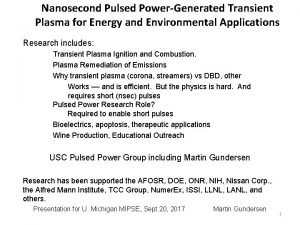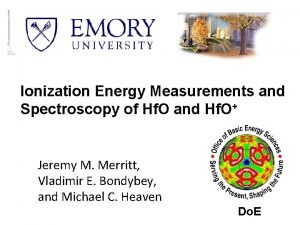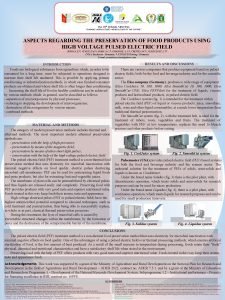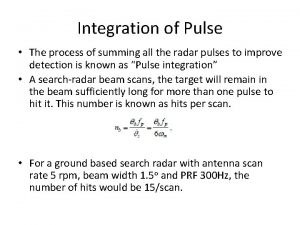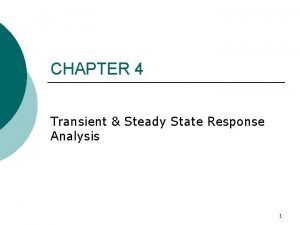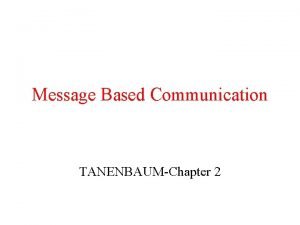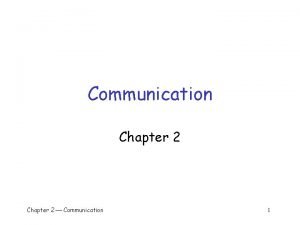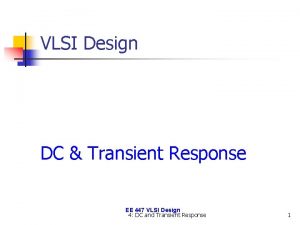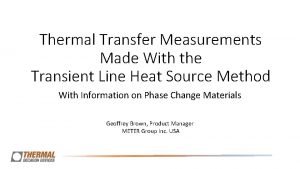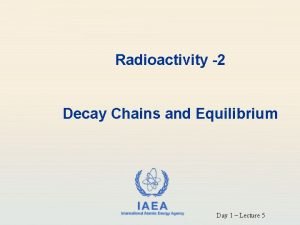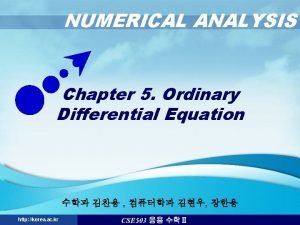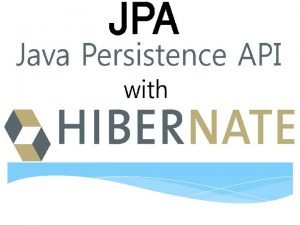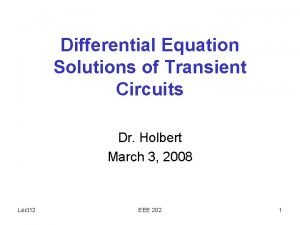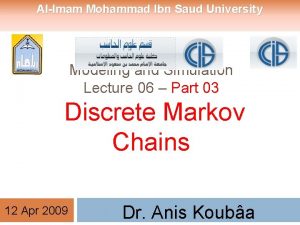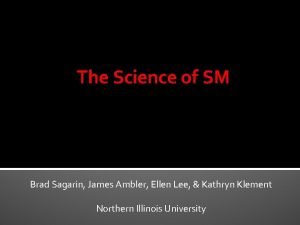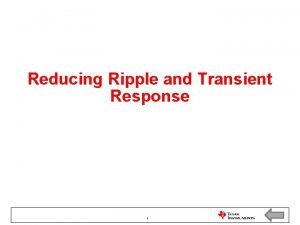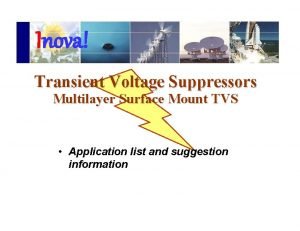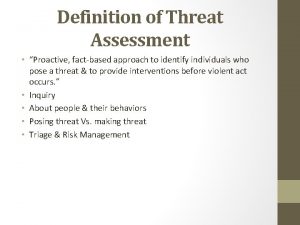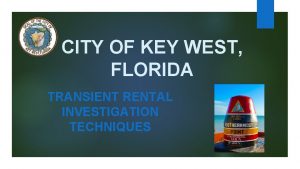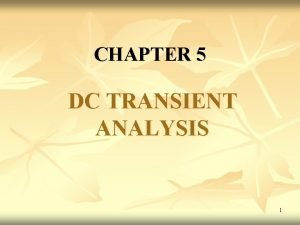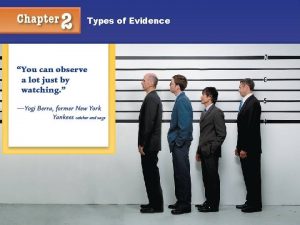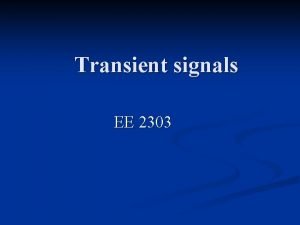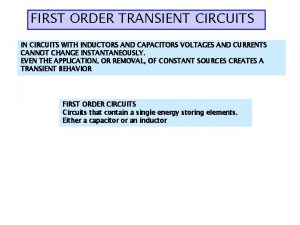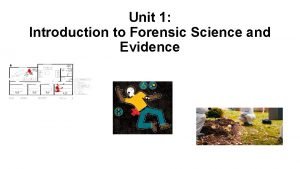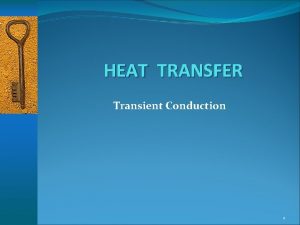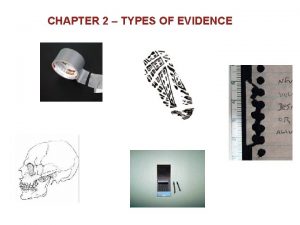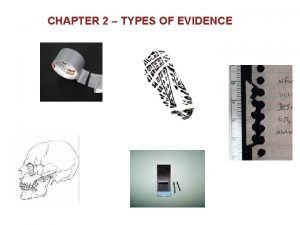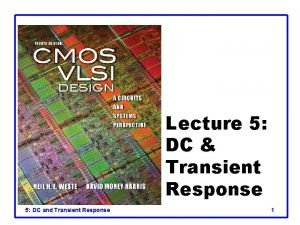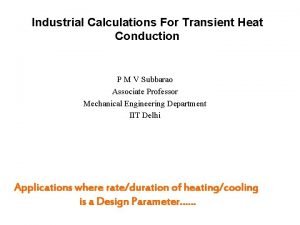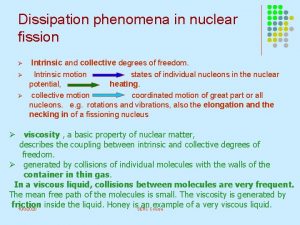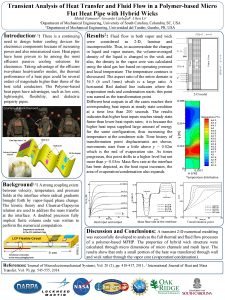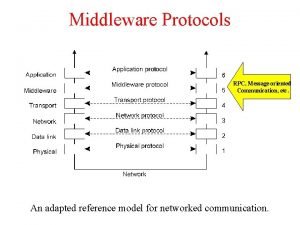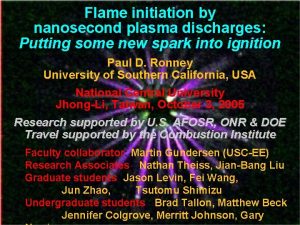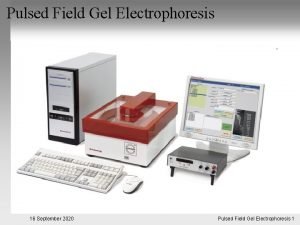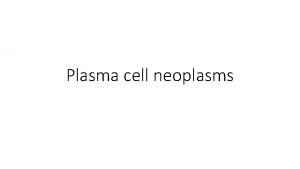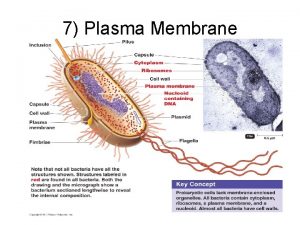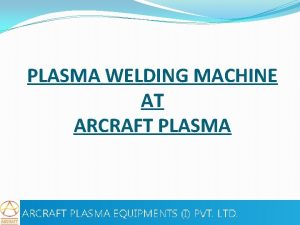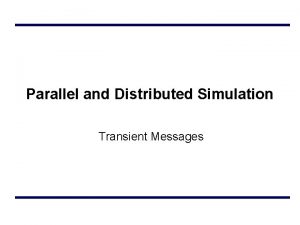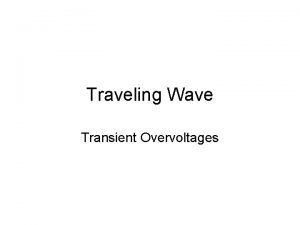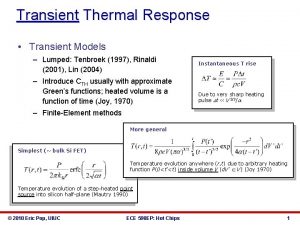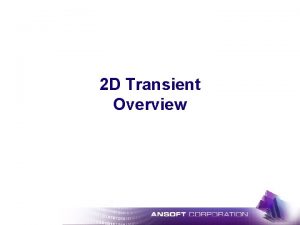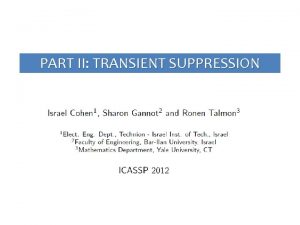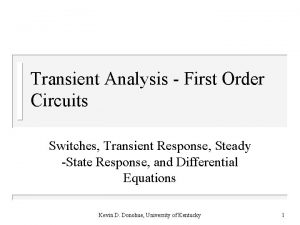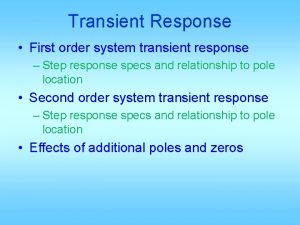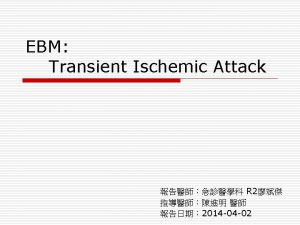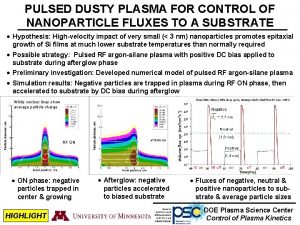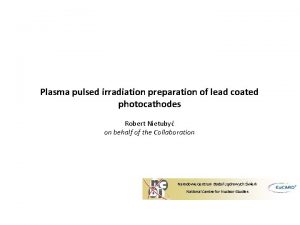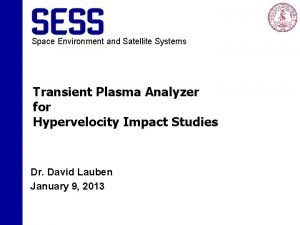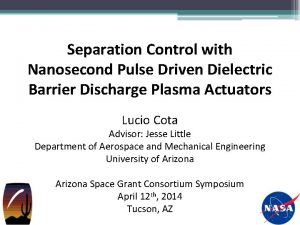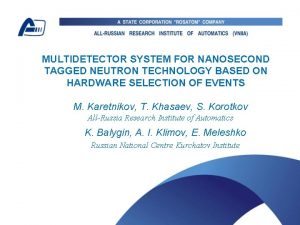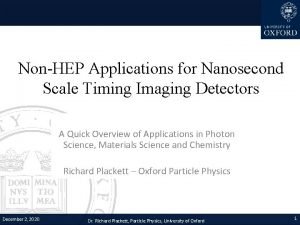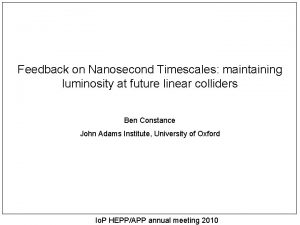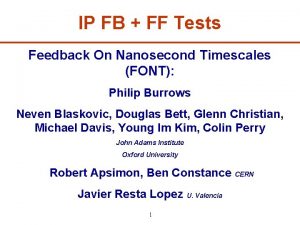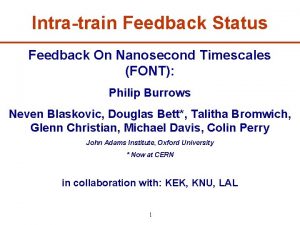Nanosecond Pulsed PowerGenerated Transient Plasma for Energy and











































- Slides: 43

Nanosecond Pulsed Power-Generated Transient Plasma for Energy and Environmental Applications Research includes: Transient Plasma Ignition and Combustion. Plasma Remediation of Emissions Why transient plasma (corona, streamers) vs DBD, other Works –– and is efficient. But the physics is hard. And requires short (nsec) pulses Pulsed Power Research Role? Required to enable short pulses Bioelectrics, apoptosis, therapeutic applications Wine Production, Educational Outreach USC Pulsed Power Group including Martin Gundersen Research has been supported the AFOSR, DOE, ONR, NIH, Nissan Corp. , the Alfred Mann Institute, TCC Group, Numer. Ex, ISSI, LLNL, LANL, and others. Presentation for U. Michigan MIPSE, Sept 20, 2017 Martin Gundersen 1

What is Pulsed Power? Example: The Sandia National Labs “Z” Machine Swimming pool-sized pulse generator. (Could have used UM “Z”)

What is Pulsed Power? Often Misunderstood Potential • There are many roles and applications for pulsed power –potential of uses still not fully understood. • Liner for the “Z” Machine (right); with current passing through, phenomenon called Z Pinch. • Fusion Research Application: • All energy is conducted through the Liner creating a ‘pulse’. o Sandia National Laboratory Fusion Program: Goal is to drive sufficient current through the Liner to compress & induce fusion. Source: SNL

Our Pulsed Power: Exploring Miniaturized Applications • Applications such as transportation require low-power, lightweight and compact systems • Size decreasing as high-voltage switch technology advances • Pulse width decreasing • Reduces energy consumption • And--Increases effectiveness

Our Pulsed Power Ignition, Combustion, and Remediation • Nanosecond Pulsed Power Enables High Power with Low-Energy • Transient plasma flame ignition – Applications: fuel flame ignition, combined cycle, pulse detonation engine, internal combustion engine, flame holding, high altitude relight – Source: Short (ns), high power, low energy pulses were observed to be effective for plasma chemistry – through true non • Contributors: thermal processes. o Dan Singleton, Bill Schroeder, Ram Srinivasan, Sanjana Kerketta, Scott – Nomenclature: Streamer, transient plasma, Pendleton, Fei Wang, Tao Tang, Andras corona Kuthi, Charles Cathey, Jianbang Liu & – Distinctive element: True non-thermal Paul Ronney (USC) electron energy distribution o Chris Brophy and Jose Sinibaldi (NPS) • Short pulse generation to produce streamers. o o o Ron Hanson, Jay Jeffries, Ethan Barbour (Stanford) M. Kushner (UI, UM, BLT Melt) Fred Schauer (WPAFRL) Effie Gutmark (U. Cincinnati) 5 Joe Shepherd (Caltech)

Diode sharpened Magnetic Compression Pulser Resonant Charging Magnetic reactor • Magnetic Compression, takes a low voltage long pulse, and compresses it through a series of LC resonant stages. • Novel diode sharpening of the pulse • 57 k. V, 20 ns (FWHM) pulse • Used to explore advantages of a shorter pulse length for ignition applications Tao Tang, A. Kuthi, F. Wang, C. Cathey, and M. A. Gundersen, “Design of 60 k. V 20 ns solid state pulse generator based on magnetic reactor driven diode opening switch , ” 27 th International Power Modulator Conference 2006, Washington D. C. , District of Columbia, May 14 -18 th, 2006. DOS sharpening Also design, build and use pseudsopark-based pulsers These are analogous to thyratron (or SCR) based, ‘line-type’ but faster rise, higher current than thyratron.

Typical Pulsed Power Design (cont. ) Managing Electromagnetic Compatibility Goal: Keep High Current Transient Signals Confined to Pulse Generator and Cable • Differential Output Cable / Electrodes o Keep high currents from flowing through system ground. • Embedded Power and Trigger Signals o Minimize exposed wires that can pick up noise. • Isolated Power Supplies All internal modules are shielded o Provide isolation from noise sensitive equipment. Optically Isolated Controller with Feedback Control Opto-isolator Feedback Circuit Timing Circuit Output Drive Features: • Optical Isolation • Variable width and amplitude • External Trigger Capability • Feedback regulates rep rate to keep it below a maximum 7

New Pulse Generators for Combustion and Medicine Specifications: Ø Ø Ø Ø 40 k. V into 200 Ω 12 ns Full-Width-Half-Max Pulse Duration 5 ns Pulse Risetime 10 k. Hz Pulse Repetition Rate (Burst) 20 k. V into 50 Ω 15 ns Full-Width-Half-Max Pulse Duration 4 ns Pulse Risetime, d. V/dt = 5 × 1012 V/s 20 k. Hz Pulse Repetition Rate (Burst)

Why? Transient Plasma → Energetic Electrons During a transient phase, prior to arc formation, there are relatively more energetic electrons -- while there is still a high voltage across the gap Reaction rate proportional to overlap. Large overlap during this time. 140 150 σ(E) EDF f(E) Electron Energy (e. V) 130 120 110 100 90 80 70 60 50 40 30 Equilibrated Discharge, Electron and gas temperature are both less than a few e. V Small overlap = small reaction rate 130 120 110 100 90 80 70 60 50 40 30 20 Typical electron distribution function, f(E), and cross section, σ(E), after first 100 ns of the discharge Typical cross section for ionization, dissociation, etc. Electron Energy (e. V) 20 After transient, or hot phase, T>100 ns, Arc Discharge – with Cold electrons σ(E) Transient Discharge, High temperature electrons. No significant change in gas temperature 10 Typical electron distribution function, f(E), and cross section, σ(E), during first 10 ns of the discharge EDF f(E) 10 For first T<10 ns There is a Transient Plasma and Hot, energetic electrons

The Associated Reactive Chemistry Example: H 2 -O 2 combustion started with non-thermal (transient plasma) H 2 e H • • • Excited species production with transient plasma With spark discharge O 2 Transient plasma dissociates molecules via electron impact Produces very reactive excited species, Increases chain branching and propagation reactions H 2 O 2 e O • H 2 Atomic oxygen is highly reactive and accelerates combustion and improves stability S. M. Starikovskaia, “Plasma Assisted Ignition and Combustion, ” J. Phys. D: Appl. Phys. 39 (2006) R 265–R 299. 10

Streamer Image (Canon EOS 10 D, 80 mm Lens, 15 sec exposure) Single Pulse Pseudospark Pulse Generator 61 k. V, 54 ns Pulse (1000 m. J) 15 mm Gap 110 k. V/cm (440 Td) Stainless Steel Porous Cathode Stainless Steel Threaded Anode (8 -32)

Transient Plasma Introduction TP Corona Discharge Streamers formed over ½ m distance, 5 cm width tube, center electrode, using pulse ≈ 50 ns at ≈ 40 k. V. Arc Discharge Same setup, but with >100 ms pulse. The streamers, which have higher energy electrons, and which fill the volume tube (left image), have degenerated into a single constricted arc, with low electron energy (right image). Streamer and arc images taken at Seaver Science Center, Los Angeles, CA Support provided by US Air Force Office of Scientific Research (US-AFOSR) 12

Two Important Areas for Use of Transient Plasma Exhaust remediation Ignition and combustion enhancement

Remediation with Transient Plasma: NOx, Soot Mid 90 s (ONR, DOE, ARO) Diesel, reactor, nsec pulses 97 -98 Program USC engine: 10 e. V/molecule Key result: Efficient remediation enabled by using short pulses (<50 nsec) Energy cost Achieved <10 ev/molecule! <5% engine energy requirement. V. Puchkarev and M. Gundersen, "Energy efficient plasma processing of gaseous emission using short pulses, " Appl. Phys. Lett. 71 (23), 3364 (1997) + patent 1997

Transient Plasma Remediation History of NOx (cont. ) Volkswagen Rabbit Experiment Co-Axial Diesel Rabbit Set-up at USC Reported CNN Future Watch Ticketed by Campus police Simple early test set-up Explored surface, corona, and silent barrier discharge cells Allowed modification of pulsed power Promise with corona, short pulse seen 15

Transient Plasma Remediation History of NOx (cont. ) Volkswagen Rabbit Experiment (cont. ) Cell Types Corona Silent Discharge Surface Discharge Plasma mufflers: Above: Various cell types investigated. Best results were achieved with corona (transient plasma) Right: Surface discharge plasma cell attached to diesel Volkswagen Rabbit.

Transient Plasma Remediation History of NOx (cont. ) Efficiency & e. V/Molecule of Various Cells NOx removal (ppm) 100 16 e. V/mol 80 12 60 40 20 • • 400 240 4 18 3 500 300 6 2 • 30 50 4 6 8 10 Joules/lit 40 80 120 Data (approximate) showing energy/molecule under various conditions, differing cell configurations. Data are for 100 ppm initial conditions NOx. Efficiency for data within ellipse corresponds to requirement of approximately 2% engine power. Low current density, transient processes, lead to efficiency V. Puchkarev and M. Gundersen, "Energy efficient plasma processing of gaseous emission using short pulses, " Appl. Phys. Lett. 71 (23), 3364 (1997) + patent 1997 17

USC 5 k. W Engine Setup Experimental setup showing Kubota diesel engine, thyratron pulser and plasma reactor.

Transient Plasma Emission Remediation Slip-Stream Experimental Setup Exhaust Engine Exhaust Reactor TPS® Pulser Horiba® PG 350 Exhaust Analyzer TSI Dust. Trak® Particle Analyzer Teledyne® UF Particle Analyzer 19

Slip-Stream USC Test Experimental Setup TPS® SSPG-40 X Pulse Generator (100 W) Particle monitoring instrumentation generously provided by the South Coast Air Quality Management District (SC-AQMD) through active collaboration on research for emissions reduction. Photo taken at Seaver Science Center University of Southern California, Los Angeles, CA All instrumentation and methodology comply with US EPA and California Air Resources Board (CARB) protocols. 20

Slip-Stream Field Test Experimental Setup Trigger Generator DC Power Supply TPS® SSPG-40 X Pulse Generator (100 W) TPER Mk. I Plasma Reactor Gas Sampling Manifold Horiba® PGA-350 Portable Gas Analyzer TSI® Dust. Trak Particle Analyzer Photo taken during field tests at the Naval Postgraduate School - Monterey, CA 21

USC Laboratory Full-Flow Setup USC TPER Mk. II Plasma Reactor USC Mk. II Reactor Provides 5000 X Increase in Scale-Up! TPS® SSPG-20 X Pulse Generator 1 k. W (x 2) Gas and Particulate Analysis Sampling Manifold TSI Dust. Trak ® Particle Monitor Teledyne ® Ultrafine Particulate Monitor Transient Plasma Reactor (x 2) 22

5 k. W Engine Load Testing (Slip-stream Data) 935 rpm 1650 rpm 2300 rpm Testing carried out in 2. 54 cm diameter cell (1. 27 cm discharge gap). Relative uncertainty in measurement = ± 3% 23

PM Remediation Results 24

Preliminary PM Remediation Results Relative uncertainty in measurement = ± 6% 25

Plasma Assisted Combustion Efficiency Transient Plasma Relief Valve Electrode for Sulzer 6 RND Photograph of TP relief valve being inserted into cylinder of Sulzer 6 RND engine aboard MARAD vessel. Photograph of nanosecond high voltage pulser and associated equipment used to generate plasma inside cylinder of Sulzer 6 RND engine aboard MARAD vessel. Left – Engineer …. . Right – (From left to right) Dr. Andras Kuthi, Galia Kaplan, Engineer, Captain Vinay Patwardhan.

Ignition Snapshots Gasoline, natural gas, other fuels Various engine types: ICE, PDE, etc.

The Rocket Part: Pulse Detonation Engines (PDE) Collaborations with the Naval Postgraduate School (NPS, Brophy), WPAFRL (Schauer et al), Stanford (Hanson et al) PDE Cycle C. Cathey, et. al. , “Transient Plasma Ignition for Delay Reduction in Pulse Detonation Engines, ” 45 th AIAA Aerospace Sciences Meeting and Exhibit, Reno, Nevada, 8 -11 Jan 2007 PDE at the NPS Rocket Lab

Greatly Improving Thrust in a PDE at the NPS Traditional spark ignition 9 ms delay USC Transient plasma ignition 2 ms delay C. Cathey, et. al. , “Transient Plasma Ignition for Delay Reduction in Pulse Detonation Engines, ” 45 th AIAA Aerospace Sciences Meeting, Reno, Nevada, 2007 Transient plasma in the NPS PDE • • • Reduced delay (shortened DDT) by ≈ factor >4 Created a detonation without added oxygen (propane-air) Increased peak pressure 4 X Higher repetition rate of the PDE means > 4 X thrust Operated at high flow rates (1/3 kg/sec)

Ignition: Small Engine Experiment AFOSR Undergraduate Capstone Project Pressure transducer installed above spark plug TPI produced 25% increase in RPM, same throttle setting indicating higher efficiency AFOSR Capstone Project, C. Li, Program Manager, Dan Singleton, Max Reynolds, Jared Fleitman, David Kingman, P Ronney, M Gundersen WPAFRL F. Schauer and J. Hoke Non-resistive spark plug with uniform gap size used for both TPI and spark

Nissan Gasoline Ignition: Increased Pressure Streamers generated via a 60 k. V, 20 ns pulse, using a modified spark plug Data taken in collaboration at Nissan, Yokohama Japan Pressure vs. crank angle, for a spark, 100 ns pulse, and 20 ns pulse, ф=. 72. • Using TPI in an ICE resulted in – 20% increase in peak pressure using less energy (57 m. J vs 80 m. J) – Faster flame propagation 1200 rpm, 100 mm-Hg, ADV: 20 deg BTDC, iso-octaneair combustion, each frame is 200 µs long. C. Cathey, T. Tang, T. Shiraishi, T. Urushihara, A. Kuthi, and M. A. Gundersen, “Nanosecond Plasma Ignition for Improved Performance of an Internal Combustion Engine, ” IEEE Trans on Plasma Sci, Dec. 2007.

High-Energy Ignition Comparison High-Energy Ignition • 10 x conventional spark energy • Frequent replacement of spark plugs Transient Plasma Briggs, T. , Alger, T. , and Mangold, B. , "Advanced Ignition Systems Evaluations for High-Dilution SI Engines, " SAE Int. J. Engines 7(4): 1802 -1807, 2014, doi: 10. 4271/2014 -01 -2625.

Engine Ignition Experiments: Typical Results Engine Type Location of Testing Typical Result Single-cylinder gasoline ICE Sandia National Labs Combustion Research Facility 20% improvement in fuel efficiency and increased stability Single-cylinder gasoline ICE Nissan Research Center 30% increase in combustion efficiency Natural gas ICE Argonne National Lab, several industrial locations Important improvement in ignition at high pressures Pulse Detonation Engine Air Force Research Lab and Office of Naval Research Lab More than 3 times improvement in thrust Continuous Detonation Engine Pratt & Whitney Rocketdyne 30% improvement in combustion efficiency

The Role of O, H 2 O During Transient Plasma Ignition Completed Work • Measured ignition delay in a PDE with transient plasma and spark discharges • Simulated OH and O 3 produced in a transient plasma discharge (John Luginsland) • Measured density of OH and O 3 produced in a transient plasma discharge (Cam Carter) Upcoming Work • Measure ignition delay in a combustion chamber with transient plasma and spark discharges { { 34

Thermal vs. Non-Thermal? Energy Distribution Studies with CARS Laser ROI (250 um x 250 um) 8 mm Recent work by USC has demonstrated that ignition occurs primarily in regions of highest E/N and active species production. We investigated the region nearest a sharp anode in a point-plane configuration with CARS and TALIF experiments. Collaboration with Aaron Montello and Prof. Walter Lempert, in labs at t. OSU 35

Experimental Setup: Two-photon Absorption Laser Induced Fluorescence Dobele, H. F. , T. Mosbach, K. Niemi, and V. Shulz-von der Gathen, 2005. Laser-Induced Fluoresence Atomic Densities: Concepts and Limitations. Plasma Sources Science and Technology. 14 S 31 -S 41. O/Xe Conversion Collaboration with Sherrie Bowman and Prof. Walter Lempert, t. OSU 36

Challenges • Transient plasma, DBD • Physics – streamer-head role in production of excited species and pathways to efficient remediation and ignition • Technology of ns pulsed power

Nano-Bio-Med Summary • • Nanosecond pulses penetrate the intracellular environment Phosphatidylserine inversion–induced apoptosis Cancer cell Studies In vivo experiments with tumors show promise New venture: Pulse Biosciences • Cardiomyocyte Studies • Cold plasma Thomas Chen Cheryl Craft Edward Garon Phil Koeffler Laura Marcu David Sawcer Miguel Valderrabano Tom Vernier Images: Top: Quantum dots in lymphocyte Below: Internal response of jurkat cell to nsec pulsed electric field KSo. M Neurology KSo. M MD, UCLA Cedars, UCLA, MD UC Davis KSo. M Dermatology UCLA Res. Assoc Prof. USC

Nano. Electro. Pulse Therapy for Cancer: in vivo study Treatment of human pancreatic cancer tumor grown on nude mice at Cedars Sinai, Koeffler group collaborating Typical results compliments of Mouse 1 (cage 154937) below: 5 x 4 x 3. 5 200 px 5 Mark 0. 5 x 1 x 0 1 week 06/30/09 7/7/09 2 weeks 7/14/09 Garon, E. B. , et. al. , “In vitro and in vivo evaluation and a case report of intense nanosecond pulsed electric field as a local therapy for human malignancies”, Int. J. Cancer 121: 675 -682, 2007

Translational Outcomes • Pulse Biosciences • Transient Plasma Systems • Integrated Applied Physics

Pulsed Electric Field treatment of wine grapes Increase • Juice yield (~30%) • Yeast digestible nitrogen (prevents “atypical aging note of the wine”*) • Tanning substances • Taste (wine) Decrease • Total processing time • Total acid

Wine Treatment with Repetitive Pulsed Power PEF Treatment of Sauvignon Blanc Wine Grapes (UC Davis) 80 Juice Yield (m. L) 70 Control PEF Treated 60 50 2 us Pulser 40 200 ns Pulser 30 12 ns Pulser 20 Control 10 0 0 100 Number of Pulses • Study of semillion and sauvignon blanc grape crush • Average juice yield increase after PEF treatment ≈30% • Beneficial compounds (antioxidants) increased M. Anderson, M. A. Gundersen, J. M. Sanders, D. R. Singleton, and A. Waterhouse, "Effects of Pulsed Energy Field Treatments on White Wine Grapes, ” Annual Meeting of the American Society for Enology and Viticulture, Napa, 2009

Acknowledgements PARTNERS SPONSORS • • • Air Force Office of Scientific Research (AFOSR) Office of Naval Research (ONR) Tai Chong Cheang Steamship Co. HK, Ltd (TCC) Current USC PULSED POWER GROUP • Prof. Martin • • Gundersen Dr. William Schroeder Dr. Alisha Lewis Dr. Andras Kuthi Sriram Subramanian Sanjana Kerketta Alec Nystrom James Williams Fernando Sierras • • Amergent Techs (AT) Transient Plasma Systems (TPS) Naval Postgraduate School (NPS) Citrus College COLLABORATORS Prof. Tom Huiskamp Prof. Mariano Rubio. Prof. Douglas Seivwright Technical University of Eindhoven Citrus College Naval Postgraduate School
 Transient plasma
Transient plasma O,hf
O,hf Pulsemaster pulsed electric field
Pulsemaster pulsed electric field Pulsed coherent radar
Pulsed coherent radar Energy energy transfer and general energy analysis
Energy energy transfer and general energy analysis Energy energy transfer and general energy analysis
Energy energy transfer and general energy analysis Steady state response example
Steady state response example Message-oriented communication definition
Message-oriented communication definition Persistent synchronous communication
Persistent synchronous communication Transient response in vlsi
Transient response in vlsi Stereotypic movement disorder
Stereotypic movement disorder Transient line source analyser
Transient line source analyser Transient equilibrium formula
Transient equilibrium formula Transient solution differential equations
Transient solution differential equations @transient in jpa
@transient in jpa Natural solution
Natural solution Examples of transient evidence
Examples of transient evidence Conditional evidence examples
Conditional evidence examples Transient markov chain
Transient markov chain Transient hypofrontality
Transient hypofrontality Ripple transient
Ripple transient Surface mount transient voltage suppressor
Surface mount transient voltage suppressor Transient threat definition
Transient threat definition Who
Who Dc transient analysis
Dc transient analysis Examples of transient evidence
Examples of transient evidence Transitional signals
Transitional signals First order transient circuit
First order transient circuit Code of conduct for healthcare support workers
Code of conduct for healthcare support workers Examples of transient evidence
Examples of transient evidence Lumped system analysis
Lumped system analysis Chapter 2 types of evidence answers
Chapter 2 types of evidence answers Examples of conditional evidence
Examples of conditional evidence Transient market segment
Transient market segment Rw + vo c inverter transient response vod inverte...
Rw + vo c inverter transient response vod inverte... Radial heat conduction
Radial heat conduction Settling time formula
Settling time formula Transient time
Transient time Transient analysis thermodynamics
Transient analysis thermodynamics Developing person through childhood
Developing person through childhood Message oriented middleware
Message oriented middleware Fspos
Fspos Typiska drag för en novell
Typiska drag för en novell Nationell inriktning för artificiell intelligens
Nationell inriktning för artificiell intelligens
